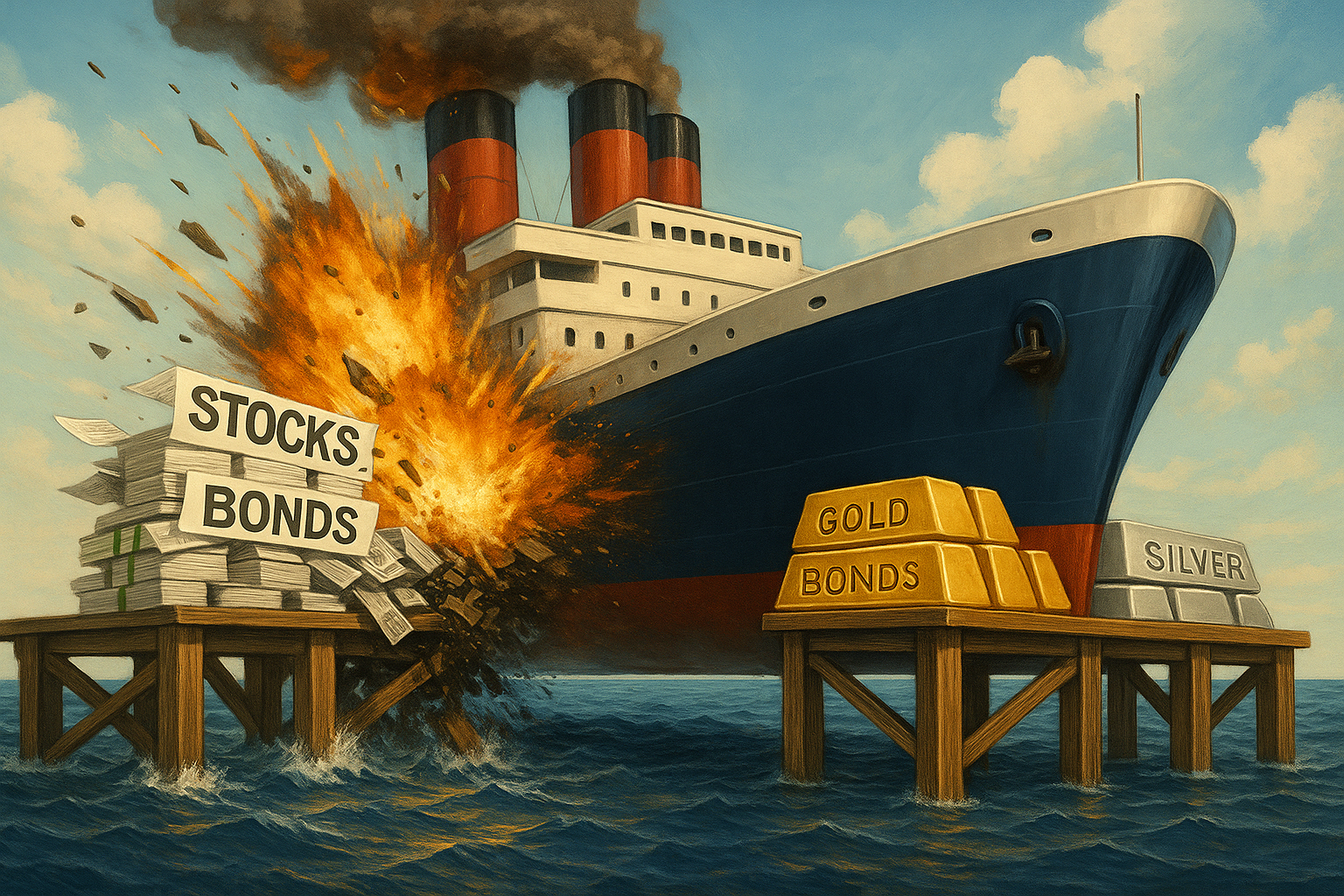Gold Has Spoken: The Silent Signals Behind a Relentless Metals Bull Market
Gold remains perched near its all-time high, casting a long shadow over financial markets that continue to misread or dismiss the deeper signals sent by those closest to the monetary fire. While silver and mining equities may appear to lag, they are not being left behind. Instead, they are building momentum in a market that is gradually awakening to a reality central banks have already acknowledged with conviction: the monetary system is evolving, and gold is the anchor.
Global central banks are not buying gold for symbolic reasons or as speculative bets. These are the most sophisticated monetary actors in the world. They do not make multi-billion-dollar purchases of bullion to decorate their balance sheets. These are deliberate, strategic acquisitions in response to an era defined by rising debt burdens, fiscal recklessness, geopolitical volatility, and deepening distrust in fiat currencies, particularly the U.S. dollar. Their actions are nonverbal cues that speak volumes for those who know how to listen.
This gold-led bull market isn’t fuelled by hype. It’s grounded in fundamentals. I began writing about these four pillars in 2005 when I created The Precious Metals Advisor, a publication dedicated to educating investors on the strategic role of gold and silver. From 2008 to 2020, during my weekly radio broadcasts on Canadian Radio channels across the country, I explored these themes in greater depth, applying them to real-world economic events as they unfolded.
My research into the historical bull markets of the 20th century revealed a striking pattern: these same four fundamentals were present during every major metals rally, including the extraordinary bull market of the 1970s. They are not only repeating themselves today - they are doing so with even greater force and global consequence. These pillars don’t just support higher metals prices now; they form the foundation for what may be a sustained and transformational revaluation of gold and silver for the next millennium to come.
The Four Fundamental Pillars of the Metals Bull Market
1. Currency Depreciation
The long-term erosion of fiat currency is not theory—it is policy. Since Nixon abandoned the gold standard in 1971, central banks have used monetary easing and interest rate manipulation as tools of economic engineering. Over the decades, this has led to deliberate, structural currency debasement. In Canada, the U.S., and much of the developed world, the purchasing power of fiat money has steadily declined.
Gold and silver are not promises or debts. They are monetary assets in their own right, preserving purchasing power across centuries of war, empire, and financial collapse. As the world races toward digital currencies and trust in fiat erodes, the demand for tangible stores of value will only grow.
Consider this: before the Obama administration, the U.S. money supply (M3) totalled approximately $800 billion. That figure reflects 219 years of economic evolution under 44 presidents, through every imaginable crisis, including (But not limited to):
- Panic of 1819
- Panic of 1837
- Long Depression (1873–1879, with effects into the 1890s)
- Panic of 1907
- World War I 1914-1918
- The Great Depression (1929–1939)
- World War II 1939-1945
- Vietnam War 1955-1975 (1973 US Pulled Out)
- Stagflation Crisis (1970s)
- Black Monday (1987)
- Gulf War 1990-1991
- Dot-Com Bust & 2001 Recession
- Global Financial Crisis (2007–2009)
All these were weathered with relatively restrained monetary policy compared to what came next. The 1970s, for example, were a radical shift. After Nixon closed the gold window in 1971, the U.S. doubled its money supply in under a decade. Yet even that era of experimentation pales in comparison to what followed.
Since 2008, however, the U.S. money supply has grown from $800 billion to over $21 trillion. That’s an increase of 26-fold in just 17 years. For perspective:
- $800 billion = $800,000,000,000
- $21 trillion = $21,000,000,000,000
This isn’t theoretical. This is monetary reality, and gold is responding in kind.
2. Inflation from Money Printing
The U.S. isn’t alone in its fiscal overreach. In Canada, under Prime Minister Trudeau and now Carneydeau, more money has been created than under all previous 22 prime ministers combined. Globally, central banks unleashed a tsunami of liquidity following the 2008 crisis and again during the COVID-19 pandemic. These actions may have prevented immediate collapse, but they also created a glut of currency units now chasing a finite supply of goods and services.
Inflation, even as headline numbers reportedly cool, is proving durable and troublesome for almost everyone. Food, housing, energy, clothing, luxury, and services remain structurally more expensive, and these costs are sticky. Inflation is not a passing glitch. It is the downstream consequence of unchecked money creation and short-sighted fiscal policy.
Gold and silver do not rely on trust or policy promises. They offer real purchasing power protection in an environment where every printed dollar undermines the next. Just look at their gains since 2005.
Gold +690%
Silver +390%
3. Geopolitical Instability
The global order is increasingly fractured, from the war in Eastern Europe to rising tensions in the South China Sea and from energy politics to internal polarization in the West. We are entering a multipolar world where economic and military power is more evenly distributed but also more volatile.
Gold thrives in chaos. It is borderless, apolitical, and free of counterparty risk. Central banks understand this better than anyone. Their historic bullion purchases are about hedging inflation and insulating reserves from the unpredictable, be it sanctions, asset freezes, or systemic shocks.
The more unstable the world becomes, the more critical physical gold becomes as a national and institutional security foundation. This, in part, explains why central banks have been net buyers of gold since 2009.
4. Supply and Demand
The supply of gold and silver is not elastic. Mine development takes years—often decades—and is capital-intensive, increasingly regulated, and geopolitically risky. Meanwhile, demand continues to rise, not just from investors but from industry.
Silver’s importance to the green energy transition cannot be overstated. It is a core component in solar panels, electric vehicles, and smart technologies. As the global economy shifts toward renewables, silver’s industrial demand will climb in tandem with its monetary appeal.
Gold, while less industrial, is seeing increased institutional and retail demand. The fundamental imbalance is intensifying with limited new supply and growing use cases for silver. The current market is only beginning to reflect this tightening dynamic.
Add to this the growing concerns of our bullion industry, which is being ravaged by a lack of accessible geography for mining, and the notion of a new world fraught with unbearable tariffs, which makes it a distinct possibility we may see decreased regional supply of both metals moving into 2026 and beyond, making our concerns about fair pricing and the ability to offer good stable supply to our Canadian base of clients a genuine fear.
Conclusion
Gold has already spoken, and the message is anything but ambiguous.
Central banks are buying, fiat currencies are depreciating, and inflation is stubborn. The global order is anything but stable. Supply is constrained, and demand is rising. These are not passing trends. They are structural shifts in how the world perceives money, trust, and value.
This bull market is not a reaction to temporary panic, but rather a recalibration. Gold and silver are being revalued for a future where sovereignty, stability, and tangible wealth matter again.
On a side note, many of our readers have hopefully weathered their own financial storms during tax season and are now in a position to put those refunds to wise use. It’s the ideal time to talk about topping up your TFSAs, RRSPs, or simply refocusing your strategy to improve your overall gold and silver holdings. At Delta Harbour, we offer several account options tailored to help you take full advantage of these opportunities.
It’s also worth noting that we have not seen the typical cyclical pullback in gold and silver prices that usually follows a strong run and is associated with the late spring of years past. Analysts increasingly view this resilience as a launching pad, not a peak. The setup for much higher metal prices is not hypothetical. It’s unfolding right before us all.
You have the knowledge. Now it requires the action.
We’re here to help you take that next step.
Yours to the penny,
Darren V. Long







